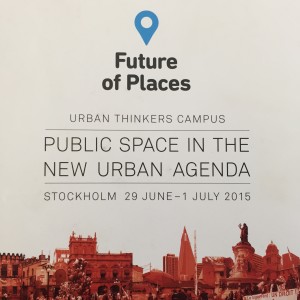Key Messages from the Future of Places:
1. People-centered approach to planning
As an arena for public use and social interaction, public spaces are most often developed, managed and maintained by municipal government. If the municipal government adopts a people-centered approach to urban planning, they will more effectively achieve sustainable development. Emphasis needs to be placed on a shared responsibility between community and private entities with regard to the localized planning and maintenance of public space.
2. Inclusive public space for all, particularly vulnerable groups
Attention needs to be given to vulnerable members of the population, including the elderly, the disabled, youth, and low income groups, to ensure their social and political inclusion in the allocation and design of public spaces. Public space has a responsibility to be flexible and open enough to serve a variety of users and uses, ranging from informal to formal settlements. Well-designed public spaces not only contribute to improve the visual and spatial character of a city, but also stimulate and enhance intergenerational, social and economic activities.
3. Public space that respects human scale and behavior
All public space needs to be of a human scale and respond to a variety of functions and patterns of use based on an understanding of human behavior, health, needs, sensibilities and aspirations. Spaces are defined by their shape and the quality of their edges. Simple temporary and tactical interventions can test and promote more permanent changes.
4. A citywide network of connected streets and public spaces
A holistic, evidence-based approach to the city is necessary with attention focused not only on the space itself, but its form, function and connectivity. Streets should serve as multimodal networks of social and economic exchange, forming the urban framework of interconnected public space. Walkability, social interaction, multimodal mobility and accessibility should be supported by a fine-grained block and street network lined with buildings providing amenities and services with a mix of uses and sizes.
5. Economic productivity of public space
Investing in public space can have powerful social, economic, cultural and health benefits. If people are committed to their future in a specific place, they invest more time and capital in that place, which has a positive impact on the local economy and creates a virtuous cycle of economic growth. Public space stimulates the small scale, local and informal economy, as well as generates tax revenue.
6. Access to public space – public and private spheres
In many places there has been a reduction of urban public space, a lack of clear boundaries between the public and private spheres and diminished freedom of expression and movement. The market alone cannot always provide a variety of public and private open spaces. A more nuanced range that provides a variety of open places, including semi-public and semi-private space is needed.
7. Sustainable public spaces that are healthy, safe, resilient, energy-conserving and resource efficient
Public space and the buildings that surround and define it need to be socially, economically and environmentally sustainable. Social sustainability requires security, equity and justice; economic sustainability benefits from affordable capital and operating budgets; environmental sustainability addresses ecological and health issues. These include clean air, water and soil, green micro-climates and the mitigation and adaptation to the Urban Heat Island Effect and Climate Change. Effective use should be made of green technologies and systems. Architecture and urban design that is adaptable and appreciated is cared for and sustained for a longer time.
8. Culture and context of public space
Public space is made unique through cultural and contextual elements that complement and enrich its identity. Spaces should be flexible and respond to the geography, climate, culture and heritage specific to its locality. Public arts can be an effective method for celebrating community identity and belonging in open spaces.
Action and Implementation:
There is a need for action and implementation mechanisms that support and protect public space and its users.
Advocacy and Mobilization
Raise awareness and create movements to mobilize stakeholders in the pursuit to build community. Promotion of discussions, forums, workshops, pop-up projects and public space prizes will further mobilize and increase awareness of and sense of belonging.
Measurement and Monitoring
Establish policy and frameworks at the national level for cities to allocate an appropriate percentage of the land to public space. An inventory of public space assets in a city will reveal the availability of public space typologies, allowing city-builders to address shortfalls and encourage a balance of public spaces throughout a city.
Public Space Financing Solutions
Examination of creative financing solutions such as public land acquisition, conversion of private space to public space or land value capture will be effective in producing greater amounts of economically sustainable public space.
Policies and Legislation for Public Space
Establish policies, legislation, and regulatory mechanisms for the provision, design, management and use of public spaces. Long-term structures, management mechanisms and partnerships at the national, regional and local level can align governments and other stakeholder’s interests. Open feedback and accountability mechanisms can ensure two-way discussions among stakeholders.
Empowerment of Marginalized Groups
Set in place processes for the inclusion of all ages, the vulnerable, and the disadvantaged. Establish a legal framework to ensure the inclusion of disadvantaged groups in public space discussion and processes. Special emphasis should be placed on job creation, livelihoods and quality of life for low-income groups.
Tools and Knowledge Management
Establish open-source knowledge management platforms with training workshops, capacity building, tools, best practices, model legislation, statistics, and methodologies for creating and managing public space. Empirical evidence-based research on the practice and theory of public space needs to be made widely available.
Future of Places, Stockholm
1 July 2015


